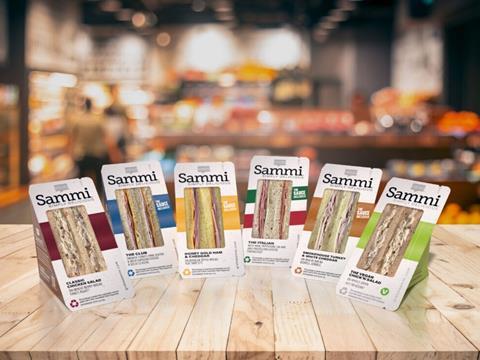
Flexible packaging company ProAmpac has teamed up with Sammi to launch a fibre-based modified atmosphere sandwich pack (MAP), designed to extend shelf-life and minimize food spoilage costs.
The ProAmpac RAP Sandwich Wedge incorporates a carton board structure with a thin transparent film liner, aiming to optimize product preservation and visibility. The company says the solution utilizes high-barrier technology to improve freshness.
ProAmpac is introducing its fibre-based MAP RAP Sandwich Wedge to the North American market in a joint effort to innovate the food–to–go packaging landscape. Designed for sandwiches and wraps, this patented technology combines the benefits of modified atmosphere packaging with mainly fibre materials.
“Sustainability lies at the heart of ProAmpac’s business strategy,” says Chad Murdock, president of ProAmpac’s fibre business. “Our collaboration with Sammi underscores ProAmpac’s commitment to helping customers meet their sustainability objectives with high-performance packaging.”
The Sammi sandwich brand has six different kinds of sandwiches including Classic Chicken Salad, The Club, Honey Gold Ham & Cheddar, The Italian, Smokehouse Turkey & White Cheddar, with a Vegan Chick’n Salad option due to be released. The brand says its sandwiches are packed fresh using fresh and sealed in a modified atmosphere environment to keep refrigerated products fresh for longer.
Back in February, ProAmpac launched a 90% fibre-based, high-barrier thermoforming solution on the European market in hopes of unlocking recyclability, efficiency, and consumer appeal for a range of food packaging. ProActive Recyclable FibreSculpt is said to be lightweight and cut down on unnecessary packaging, designed to fulfil consumer demand for renewable packaging materials.
Later that month, Paboco announced that full-scale production for its paper-based bottle product had commenced at its manufacturing site in Slangerup, Denmark – aspiring to produce over 20 million fibre-based bottles by the end of 2025. According to Paboco, the solution is 85% paper, with the remaining 15% consisting of an HDPE barrier; however, the exact percentages vary depending on the bottle shape and intended application.
If you liked this story, you might also enjoy:
Report: The ultimate guide to global plastic sustainability regulation
The Brief: Oxo-(bio)degradables: the who, what, and why of breaking down fossil-based plastics
Sustainable Packaging Summit: How Kraft-Heinz uses collaboration to drive innovation
The Brief: Using ocean-bound plastic in packaging – how, why and should we?











No comments yet